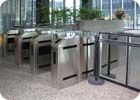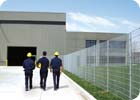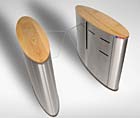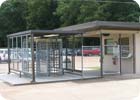As the Perimeter Turns

Turnstiles can provide higher level security but also blend into the look and feel of a corporation or building lobby. Photo of optical portals courtesy of Automatic Control Systems
Think of an onion. That’s what chief executive officers and chief security officers visualize about protecting their people, facilities and assets.
That onion is a group of layers. So is security.
Among the enterprise layers are the physical perimeter. In these areas, there are access controls ranging from guardhouses and fences to turnstiles and even systems integrated with revenue controls.
The lobby is the heart of a building and often the parking lot or garage is the real entrance.

Sturdy, welded wire fence systems open the doors for projects requiring higher security while reducing the vandalism associated with legacy chain link fence designs.

Next generation turnstiles combine intelligence, speed, accuracy and tailgater detection with glass barriers that recess into the pedestals for authorized personnel. Photo courtesy of Smart Security Systems
There also are access systems that combine security with financial and revenue needs. Taking an enterprise-wise approach, the Metro Toronto (Canada) Convention Centre (MTCC) automated and integrated vehicle access and revenue control systems with additional payment options including high-speed credit card transactions. One recent option: six “pay-on-foot” stations, according to MTCC Vice President of Operations Vince Quattrociocchi. PARC Automation provided the design and installation for the system integration, and provides ongoing service for the system.
The system can also create bulk pre-paid vouchers, event passes and multiple day passes using a burster and ticket vault. These stored value passes can be created at any station. Each pass is encoded with a magnetic stripe on either thermally printed ticket stock or plasticized longer-term stock.

Shelters prevent trespassers from climbing turnstiles to gain access to secured areas.
Photo courtesy of Porta-King
Photo courtesy of Porta-King
MORE INTELLIGENCE
No doubt, when you get inside facilities, building owners and operators now seek more computer and communications intelligence in their turnstiles.For example, next generation equipment combines intelligence, speed, accuracy and tailgate detection with glass barriers. Such optical turnstile systems are, in essence, extremely intelligent computers. Unlike relying on PLC logic, every lane has a microprocessor programmed with advanced neural network algorithms.
Especially inside facilities and especially in high-rise lobbies, the look of turnstiles is very important. It is important to eliminate a “mass transit” look in lobbies and areas where owners prefer discreet, extremely effective security measures to protect tenants and other assets.
At other times, and often outdoors around a facility perimeter or parking lot or garage, CEOs and CSOs often prefer a harder security look while not wanting unsightly or bulky enclosures. Michel Mongeau of Omega II Fence Systems added that chief security officers and facility managers now consider sturdy, welded wire fence systems designed for projects requiring higher security while reducing the vandalism associated with legacy chain link fence designs.
Of course, perimeter security, access control, electronic detection, surveillance and building security may be set up via different vendors.
This approach can make integration of security components and technology quite difficult. Choosing the best supplier to secure an integrated solution that maintains the integrity and compatibility of an enterprise security system is critical. A large chemical manufacturing company had an unconnected multi-tiered security system at its worldwide locations; using unique technology, it integrated electronic detection, surpassing levels suggested through homeland security and industry initiatives. An example, the LightForce system, analyzes any light variations through six different parameters of the light spectrum. Along with intensity and Fourier and Laplace analysis, the system considers attributes such as color, frequency, bandwidth and temperature in its evaluation. Using algorithms and filters, such an approach recognizes the installed environment to limit disturbances that could otherwise be registered as break-in attempts.
Then there are shelters to protect turnstiles and employees from the elements.
The shelters protect people, sensitive keycard readers and access control equipment from the weather, but also add an extra level of security by preventing trespassers from climbing turnstiles to gain access to secured areas.
SIDEBAR: Turn to Full Height Turnstiles
Turnstiles aren’t just for busy building lobbies, according to Curtis Lamson of Designed Security, Inc. Full height turnstiles are ideal for indoor and outdoor applications where added security and high pedestrian traffic are priorities, including unattended locations in a facility where only authorized employee access is allowed. While providing a true access control barrier, many of these units will still control high throughput traffic flow of up to 20 people per minute per turnstile. Most are also compatible with any major access control system.Looking for a reprint of this article?
From high-res PDFs to custom plaques, order your copy today!





